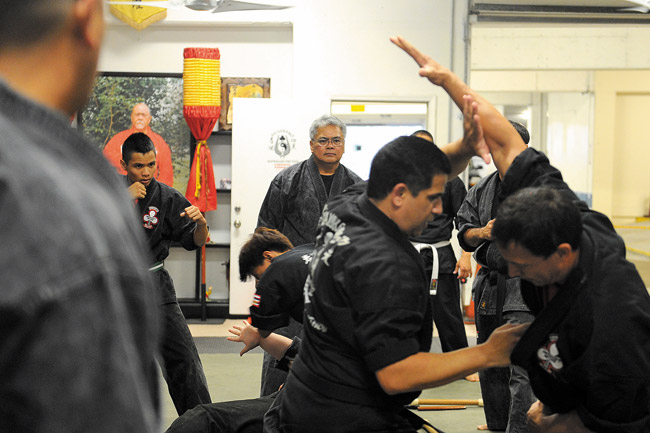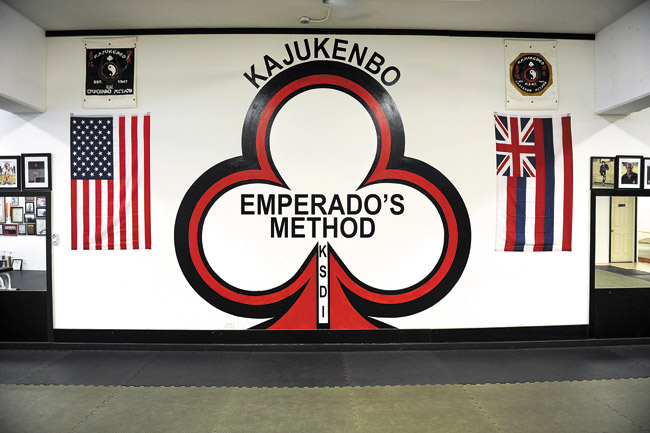The First Mixed Martial Art
Clarence Emperado Luna’s stepfather created Kajukenbo — A combination of Karate, Judo, Kenpo and Boxing — And now he’s carrying on the legacy
Imagine challenging world-renowned fighter Bruce Lee to a duel. Now imagine Lee declining the offer, saying he would never spar with a master of kajukenbo.
This is a story Clarence Emperado Luna, son of kajukenbo founder Sijo Adriano D. Emperado, loves telling.
“It was back in the ’70s,” Emperado Luna starts. “I was in intermediate school going to Central (middle school).”
His mom Linda and stepdad Emperado went to an international tournament in Long Beach, where they happened to sit next to Bruce Lee and his wife Linda. Naturally, the two Lindas hit it off, which allowed Sijo Emperado and Lee to engage in their own discussion.
Sijo Emperado urged Lee to meet him on the mat after the tournament to see the difference between Lee’s fighting arts and kajukenbo.
“And Bruce Lee said, ‘No. I would never fight a kajukenbo,'” Emperado Luna says.
Just what makes kajukenbo such a respected martial art?
Emperado Luna explains that the fight style is the world’s first mixed martial art, and includes every aspect of self-defense. The name itself reflects the five fight styles merged by Sijo Emperado: Ka (Korean karate), Ju (judo and jiu-jitsu), Ken (kenpo or kempo), and Bo (Chinese boxing or kung fu). The symbols in the kajukenbo name also have a secondary meaning: “Through this fist style, one gains long life and happiness.”
Sijo Emperado created the art form thanks to four masters: Peter Young Yil Choo (Korean karate), Joe Holock (judo), Frank Ordonez (jiu-jitsu), and Clarence George Chang (kung fu and Chinese boxing). The art of Chuan-Fa kung fu was incorporated in 1959.
“They shared each other’s-knowledge back and forth in the ’40s,” Emperado Luna says, “and that’s why they call themselves the Black Belt Society.”
The group worked together for two years before the Korean War, but once the war started the four masters went off to fight while Sijo Emperado stayed back home in Hawaii as part of the harbor police.
“He started breaking down the names and started pulling each segment from each background, and he formed the kajukenbo system in the state of Hawaii,” continues Emperado Luna.
Sijo Emperado’s Method started with a three-leaf clover as a sign of kajukenbo schools he founded in Palama Settlement, Kaimuki and Wahiawa.
From these schools, several black belt students traveled to San Francisco and started spreading the fire of kajukenbo.
From Hawaii, Sijo Emperado founded Kajukenbo Self-Defense Institute Inc. (KSDI), and the art started growing rapidly and now spans international boundaries.
Emperado Luna grew up in housing projects, and the eight people in his family were on welfare.
“We were struggling, but we had a lot of love,” he adds.
While growing up, he was fortunate to have Sijo Emperado come into his life after his parents’ divorce to help raise him and teach him the famous mixed martial art.
When Emperado Luna graduated from McKinley High in 1976 at the age of 18, he made the decision to move out of his parents’ house.
Sijo Emperado asked him what he wanted to do when he grew up. Emperado Luna’s response?
“I said I’m going to buy a condominium, get a job, and I’m going to get a nice sports car and I’m going to die of AIDS,” Emperado Luna says with a laugh. “He told me to raise my hand, and I thought he was going to break my fingers.”
Instead, Sijo Emperado urged him to get a trade and get a degree — words of wisdom Emperado Luna took seriously.
Other than being the caretaker of kajukenbo, he has dual degrees in graphic arts (Leeward Community College) and commercial arts (Honolulu Community College) and upon graduating also spent some time teaching in the respective fields.
“Nobody knew I was teaching,” says Emperado Luna, a Kaneohe resident who at the time was working the night shift with the Honolulu Advertiser since 1978. Today he does maintenance on the Oahu Publications press at Kapolei.
He also has a degree in carpentry from HCC and took classes in police science and drafting.
Emperado Luna eventually made his way to the day shift.
“I was kind of bored, so for three years I carried a gun and a badge,” he says. “I almost shot an old lady and a homeless person.”
Sijo Emperado once asked him, “What else didn’t you get into yet?”







